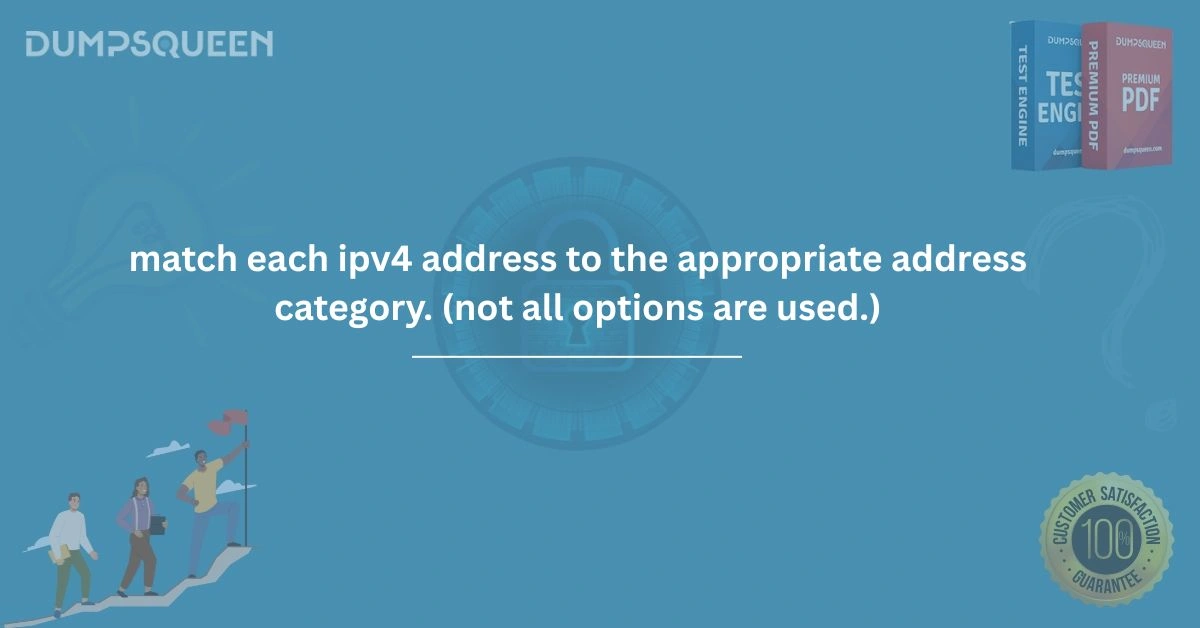Introduction
In the vast world of networking, understanding how IP addresses are structured, categorized, and applied in real-world environments is a foundational skill. Whether you're an aspiring network engineer or preparing for a certification exam, it's essential to comprehend how IPv4 addresses function and how to match each IPv4 address to the appropriate address category. (Not all options are used.) At DumpsQueen, we’re committed to helping learners decode the complex language of networking. In this guide, we will deeply explore the IPv4 address system, explain each category with examples, and prepare you for questions that often appear in networking certifications like Cisco’s CCNA (200-301), CompTIA Network+, and others. By the end of this article, you'll not only understand IPv4 address classes and categories but also feel confident identifying them in real-world and exam scenarios.
What Is an IPv4 Address?
An IPv4 address is a 32-bit numerical label assigned to each device participating in a computer network that uses the Internet Protocol for communication. These addresses are written in dotted-decimal format and consist of four octets (8-bit sections), separated by periods. For example, 192.168.1.1 is a common IPv4 address. Each IPv4 address consists of two main components: the network portion and the host portion. These two parts help route data appropriately within and across networks. The design of IPv4 also led to the need for categorizing addresses into classes and special-use ranges.
IPv4 Address Categories and Their Role in Networking
To properly match each IPv4 address to the appropriate address category, one must first be familiar with the most common categories. IPv4 addresses are grouped into five primary classes: A, B, C, D, and E. Additionally, there are special-use addresses that don’t belong to traditional classes but play critical roles in networking, such as private addresses, loopback addresses, link-local addresses, and multicast addresses. Let’s examine each category closely and understand their usage.
Class A Addresses
Class A addresses range from 1.0.0.0 to 126.255.255.255. They are designed to support very large networks because the first 8 bits (or first octet) are reserved for the network part, and the remaining 24 bits are used for host identification. An address like 10.25.56.78 falls within this category. This class is commonly used for large-scale organizations with thousands or even millions of devices. Private Class A addresses range from 10.0.0.0 to 10.255.255.255.
Class B Addresses
These addresses span from 128.0.0.0 to 191.255.255.255. Class B uses the first two octets for the network and the last two for hosts. This structure is ideal for medium-to-large networks. An example of a Class B address is 172.16.0.1. Note that the range from 172.16.0.0 to 172.31.255.255 is reserved for private usage.
Class C Addresses
Ranging from 192.0.0.0 to 223.255.255.255, Class C addresses are best suited for smaller networks. In this class, the first three octets represent the network, while the last octet is for the host. A typical Class C IP would be 192.168.1.100. The range 192.168.0.0 to 192.168.255.255 is used for private IP addressing in home and small business environments.
Class D Addresses (Multicast)
Class D addresses, from 224.0.0.0 to 239.255.255.255, are reserved for multicast groups. These are not assigned to individual hosts but are used for group communication, such as streaming media or online conferencing. An example of a Class D address is 224.0.0.5, used in OSPF routing protocol for multicasting to routers.
Class E Addresses (Experimental)
Class E includes IPs from 240.0.0.0 to 255.255.255.254. These addresses are reserved for experimental purposes and are not intended for public or private network assignment. You won't find Class E addresses used in practical applications.
Loopback Addresses
The IPv4 loopback address is 127.0.0.1, used to test network interface functionality without communicating over a physical network. It confirms that the TCP/IP stack is correctly installed. If you're trying to match each IPv4 address to the appropriate address category, remember that anything within 127.0.0.0/8 is loopback.
Link-Local Addresses
IPv4 link-local addresses range from 169.254.0.0 to 169.254.255.255. These addresses are automatically assigned when a device fails to obtain an IP address from a DHCP server. They’re often seen in peer-to-peer connections within the same local network segment. For example, 169.254.1.1 is a typical link-local address.
Broadcast Addresses
Broadcast addresses are used to send traffic to all hosts on a network. The most commonly referenced broadcast IP is 255.255.255.255, which sends a message to all nodes in the local network. Additionally, within subnets, the broadcast address is the highest address in that subnet range. For example, in a subnet of 192.168.1.0/24, the broadcast address is 192.168.1.255.
Reserved and Private Ranges
Certain IP address blocks are reserved for private network use. These are defined in RFC 1918 and include:
-
10.0.0.0 – 10.255.255.255(Class A Private) -
172.16.0.0 – 172.31.255.255(Class B Private) -
192.168.0.0 – 192.168.255.255(Class C Private)
These addresses are non-routable on the public internet and are essential for NAT (Network Address Translation) implementations.
Matching the IPv4 Address to the Correct Category
Now that we’ve understood the various categories of IPv4 addresses, let’s focus on how to match each IPv4 address to the appropriate address category when presented with multiple options in a question.
Consider the following list of IPs:
-
192.168.1.1 -
127.0.0.1 -
10.0.0.5 -
224.0.0.9 -
169.254.100.23
Let’s assign each:
-
192.168.1.1→ Class C Private -
127.0.0.1→ Loopback -
10.0.0.5→ Class A Private -
224.0.0.9→ Class D (Multicast) -
169.254.100.23→ Link-Local
In many certification exams, you'll be given a list of IPv4 addresses and asked to match each IPv4 address to the appropriate address category. (Not all options are used.) You must be able to identify and discard the distractors confidently.
Real-World Use of Address Categories
In enterprise networks, network architects segment networks using different IP ranges. For internal connectivity, they use private address spaces usually from Class A or C ranges. When devices communicate externally, NAT is used to translate these private IPs into routable public IPs. Service providers may use Class A or B IPs for large-scale infrastructure, while technologies like video conferencing, VoIP, or OSPF rely on multicast addresses (Class D). Understanding these practical implementations reinforces your ability to match IPv4 addresses to categories on the fly.
Importance of IPv4 Categorization in Exams
Certifications like CCNA, CompTIA Network+, and Microsoft networking exams frequently include questions related to IP address classifications. DumpsQueen has been helping thousands of IT professionals succeed by offering updated and exam-oriented dumps, including practice questions on topics like this. Recognizing the address range and understanding what each category is used for helps you not only in passing exams but also in real-world troubleshooting and design.
Free Sample Questions
Question 1: Which of the following IPv4 addresses belongs to a multicast category?
A. 192.168.1.1
B. 10.10.10.10
C. 224.0.0.1
D. 127.0.0.1
Correct Answer: C. 224.0.0.1
Question 2: Which IP address is reserved for loopback testing?
A. 169.254.0.1
B. 192.168.100.1
C. 127.0.0.1
D. 10.0.0.1
Correct Answer: C. 127.0.0.1
Question 3: Which of the following is a valid Class A private IP address?
A. 172.16.0.1
B. 192.168.1.1
C. 10.20.30.40
D. 224.1.1.1
Correct Answer: C. 10.20.30.40
Question 4: What category does the IP address 169.254.1.5 fall into?
A. Class B
B. Loopback
C. Link-local
D. Public
Correct Answer: C. Link-local
Conclusion
IPv4 address classification is more than just a memorization task it's a critical skill that allows you to design, secure, and troubleshoot networks effectively. Being able to match each IPv4 address to the appropriate address category (not all options are used) is essential for passing networking certifications and succeeding in your IT career. At DumpsQueen, we provide reliable, up-to-date resources and practice questions that mirror real exam formats. If you're serious about acing your next networking certification, start practicing with our verified dumps today. Understanding concepts like IPv4 addressing is your first step toward becoming a networking expert. Ready to level up? and get the edge you need.




